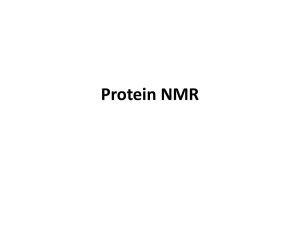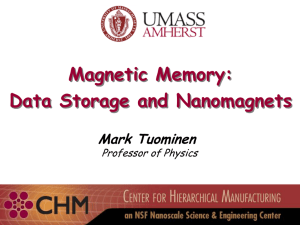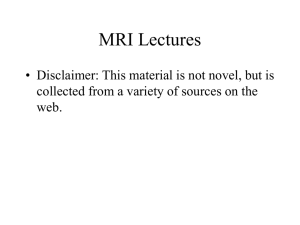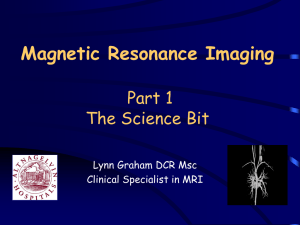Magnetic Resonance Imaging
advertisement
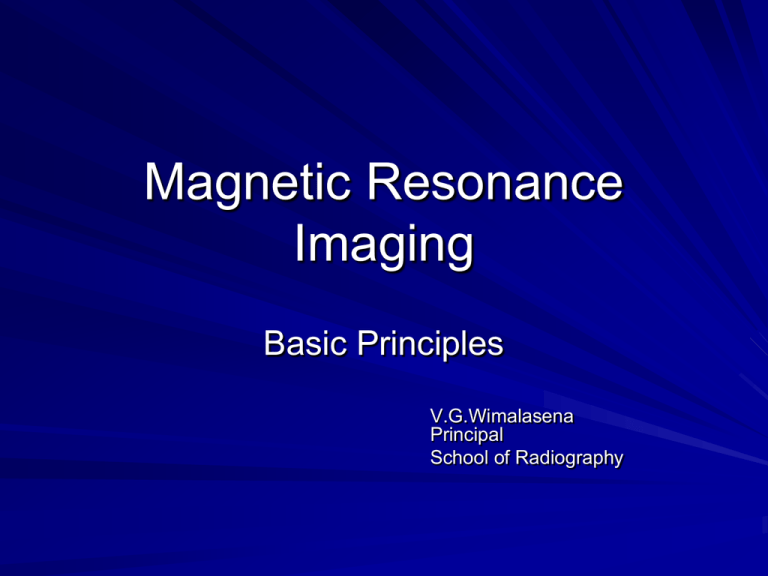
Magnetic Resonance Imaging Basic Principles V.G.Wimalasena Principal School of Radiography Introduction Modern 3 Tesla MRI unit Main magnet body Patient Couch Bore of the magnet RF Coil (for head) What is MRI? Magnetic resonance imaging (MRI), or nuclear magnetic resonance imaging (NMRI), is primarily a Medical Imaging technique most commonly used in radiology to visualize the structure and function of the body. It provides detailed images of the body in any plane. MRI Vs CT MRI provides much greater contrast between the different soft tissues of the body than CT does, making it especially useful in neurological (brain), musculoskeletal, cardiovascular, and oncological (cancer) imaging. Unlike CT, it uses no ionizing radiation, but uses a powerful magnetic field to align the nuclear magnetization of (usually) hydrogen atoms in water in the body. Uses RF fields Radiofrequency fields are used to systematically alter the alignment of the nuclear magnetization of Hydrogen atoms, causing the hydrogen nuclei to produce a rotating magnetic field detectable by the scanner. This signal can be manipulated by additional magnetic fields to build up enough information to construct an image of the body. History MRI is a relatively new technology, which has been in use for little more than 30 years (compared with over 110 years for X-ray radiography). The first MR Image was published in 1973 and the first study performed on a human took place on July 3, 1977. Magnetic resonance imaging was developed from knowledge gained in the study of nuclear magnetic resonance Brief lay explanation of MRI physics The body is mainly composed of water molecules which each contain two hydrogen nuclei or protons. When a person goes inside the powerful magnetic field of the scanner these protons align with the direction of the field. A second radiofrequency electromagnetic field is then briefly turned on causing the protons to absorb some of its energy. When this field is turned off the protons release this energy at a radiofrequency which can be detected by the scanner. The position of protons in the body can be determined by applying additional magnetic fields during the scan which allows an image of the body to be built up. These are created by turning gradients coils on and off which creates the knocking sounds heard during an MR scan. Diseased tissue, such as tumors, can be detected because the protons in different tissues return to their equilibrium state at different rates. By changing the parameters on the scanner this effect is used to create contrast between different types of body tissue. Use of contrast agents Contrast agents may be injected intravenously to enhance the appearance of blood vessels, tumours or inflammation. Contrast agents may also be directly injected into a joint, in the case of arthrograms, MR images of joints. Safety precaution Unlike CT scanning MRI uses no ionizing radiation and is generally a very safe procedure. But Patients with some metal implants, cochlear implants, and cardiac pacemakers are prevented from having an MRI scan due to effects of the strong magnetic field and powerful radiofrequency pulses. Uses of MRI MRI is used to image every part of the body, But is particularly useful in – neurological conditions, – disorders of the muscles and joints, – for evaluating tumors and – showing abnormalities in the heart and blood vessels. System components Magnet power supply Shim power supply Gradient amplifiers RF transmitter Operator consol Magnet coils Shim coils Gradient coils RF coils Host computer Magnet bore Image processor Image disk RF receiver Digitizer Explaining Basic principles This is an Integration of Two ways of explaining. i. e Classically Via quantum physics It describes Properties of atoms Their interaction with magnetic fields Atomic structure Central nucleus & orbiting electrons Nucleus – Nucleons (Protons & neutrons) Atomic number Mass number Electrically stable Motion within the atom There are three types of motion within an atom 1. Electrons spinning on their own axis 2. Electrons orbiting the nucleus 3. The nucleus spinning about its own axis The principles of MRI rely on the spinning motion of specific nuclei present in biological tissues These are called (MR active nuclei) MR active nuclei ? MR active nuclei are Characterized by their tendency to align their axis of rotation to an applied magnetic field Due to the laws of electromagnetic induction, nuclei that have a net charge and are spinning acquire a magnetic moment and are able to align with an external magnetic field MR active nuclei continued.. Important Examples The nuclei with odd mass numbers undergoes this interaction The result of this interaction is angular momentum or spin Hydrogen Carbon Nitrogen Oxygen Fluorine Sodium Phosphorus 1 13 15 17 19 23 31 The magnetic moment alignment The alignment of the magnetic moment is measured as the total of the nuclear magnetic moments and is expressed as a vector sum The strength of the total magnetic moment is specific to every nucleus and determines the sensitivity to magnetic resonance The hydrogen nucleus The hydrogen nucleus is the MR active nucleus used in clinical MRI Very abundant in the body Solitary proton gives a relatively large magnetic moment The hydrogen nucleus as a magnet The nucleus contains one positively charged proton that spins The spin of the proton induces a magnetic field around it and acts as a small magnet N S N S The magnetic vector The magnetic moment of each nucleus has vector properties. i.e. it has size and direction and is denoted by an arrow direction Alignment of the magnetic moments In the absence of an applied magnetic field the magnetic moments are randomly oriented When placed in a strong external magnetic field the magnetic moments of the hydrogen nuclei align with this magnetic field , parallel or anti-parallel (as shown in next slide) Alignment of the magnetic moments Parallel Random alignment in the absence of external magnetic field Anti-parallel Alignment External magnetic field The state of alignment Quantum physics describes that the hydrogen nuclei only possesses two energy states or populations – low & high Low energy nuclei align their magnetic moments parallel to the external magnetic field High energy nuclei align their magnetic moments anti-parallel to the external magnetic field Energy levels & field strength Energy difference depends on field strength Low energy population high energy population Energy levels & alignments The energy level and the number of nuclei aligned in each direction is determined by the strength of the external magnetic field and the thermal energy level of the nuclei Low thermal energy nuclei do not have enough energy to oppose the field and align parallel High thermal energy nuclei have sufficient energy to oppose and may align antiparallel Alignment & field strength Thermal energy depends on the body temperature The main deciding factor to increase the number of parallel alignments is the high field strength of the external magnetic field At thermal equilibrium the parallel population is higher than the anti-parallel population Therefore there is a net magnetic moment parallel to the external magnetic field The net magnetization vector B0 Net Magnetization Vector (NMV) Summary The magnetic moment (of hydrogen in this case) is called the Net Magnetization Vector (NMV) The static external magnetic field is called B0 The interaction of the NMV with B0 is the basis of MRI The unit of B0 is Tesla or Gauss. 1 Tesla (T) = 10000 Gauss (G) Summary continued… When a patient is placed in the bore of the magnet the hydrogen nuclei within the patient align parallel and anti-parallel to B0. A small excess of hydrogen nuclei line up parallel to B0 and constitute the NMV of the patient. The energy difference between the two populations increases as B0 increases. The magnitude of NMV is larger at high field strengths(B0 ) Precession Each hydrogen nucleus that makes up the NMV Precessional path is spinning on its own axis The influence of B0 B0 produce an additional spin or wobble Magnetic Precession This path is called the moment precessional path and of the the speed at which the nucleus NMV wobbles around B0 is called the precessional frequency Hydrogen nucleus Precession continued…. Two populations; High energy nuclei – spin down Low energy nuclei – spin up Their magnetic moments precess on a circular path around B0 as shown Spin up nuclei B0 Precession Spin down nuclei The Larmor equation The value of the precessional frequency is governed by the Larmor equation i.e The precessional frequency (ω0) = Magnetic field strength(B0) x Gyro-magnetic ratio(γ) ω 0 = B0 x γ Gyro-magnetic ratio is a constant for a specific MR active nucleus and is expressed as the precssional frequency at 1.0 tesla. The unit is MHz / T Precessional frequencies of Hydrogen γ B0 ω 1.5 T 63.86 MHz 42.57 Mhz/T 1.0 T 42.57 MHz 0.5 T 21.28 MHz Resonance Resonance is a phenomenon that occurs when an object is exposed to an oscillating perturbation that has a frequency close to its own natural frequency of oscillation. At resonance the object can absorb energy from the external source Therefore Exchange of energy between two systems at a specific frequency is called resonance. Nuclear Resonance When a nucleus is exposed to an external perturbation that has an oscillation similar to its own natural frequency, the nucleus gains energy from the external force. The nucleus gains energy and resonates if the energy is delivered at exactly its precessional frequency. RF signal & Nuclear magnetic Resonance Energy at the precessional frequency of hydrogen at all field strengths in clinical MRI corresponds to the radio frequency (RF) band of the electromagnetic spectrum For resonance of hydrogen to occur, an RF pulse of energy at exactly the Larmor frequency of the hydrogen NMV must be applied Other MR active nuclei that have aligned with B0 do not resonate because their precessional frequencies are different to that of hydrogen Excitation & RF frequency The application of an RF pulse that causes resonance to occur is termed excitation. The absorption of energy causes an increase in the number of spin down hydrogen nuclei populations as some of the spin up nuclei gain energy via resonance and become high energy nuclei (next slide) The energy difference corresponds to the energy required to produce resonance via excitation Energy transfer during excitation Low energy population Some nuclei gain energy to join the high energy population High energy population The results of resonance The first result is the NMV moves out of alignment away from B0 The angle to which the NMV moves out of alignment is called the flip angle The magnitude of the flip angle depends upon the amplitude and duration of RF pulse Usually the flip angle is 900 (see next slide). The transverse NMV rotates at the Larmor frequency The flip angle & Transverse plane B0 is now termed the longitudinal plane The plane at 900 to B0 is termed the transverse plane Longitudinal plane Longitudinal plane B0 Flip angle NMV Flip angle 900 NMV Transverse plane Transverse plane In phase / out of phase The second result of resonance is that the magnetic moments within the transverse NMV move into phase with each other Phase is the position of each magnetic moment on the precessional path around B0 Magnetic moments that are in phase are in the same place on the precessional path around B0 at any given time MM that are out of phase are not in the same place on the precessional path Phase of magnetic moments around the precessional path Out of phase In phase Summary For resonance of hydrogen to occur, RF at exactly the Larmor frequency of hydrogen must be applied The result of resonance is an NMV in the transverse plane that is in phase This NMV precesses in the transverse plane at the Larmor frequency The MR signal Formation of MR signal after removal of RF pulse The MR signal As a result of resonance the NMV is precessing in phase in the transverse plane. According to Faraday’s laws of induction, When a receiver coil (a conductive loop) is placed in the area of moving magnetic field a voltage is induced in it. This Signal is produced when coherent (in phase) magnetization cut across the coil. MR signal continued…. Therefore the moving NMV produces magnetic field fluctuations inside the coil As the NMV precesses at the Larmor frequency in the transverse plane a voltage is induced in the coil. This voltage constitutes the MR signal The frequency of the MR signal is the same as the Larmor frequency The magnitude of the MR signal depends on the amount of magnetization present in the transverse plane Generation of the MR signal in the receiver coil B0 NMV Receiver coil Relaxation & The free induction decay signal Switching off RF pulse Relaxation Recovery & decay FID Relaxation When the RF pulse is turned off the NMV is again influenced by B0 , and, it tries to realign with it. To do that it must lose the energy given to it by the RF pulse. The process by which the NMV loses energy is called relaxation Recovery & Decay As relaxation occurs the NMV returns to align with B0 When this happens, The amount of magnetization in the longitudinal plane gradually increases – this is called recovery The amount of magnetization in the transverse plane gradually decreases – this is called decay The free induction decay signal As the magnitude of transverse magnetization decreases so does the voltage induced in the receiver coil. The induction of this reduced signal is called the free induction decay (FID) signal Result of relaxation During relaxation The NMV gives up absorbed energy and returns to B0 The magnetic moments of the NMV lose the transverse magnetization due to dephasing Looking down on to transverse plane In phase Dephasing Out of phase T1 Recovery & T2 Decay Relaxation results in recovery of magnetization in the longitudinal plane and decay of magnetization in the transverse plane. The recovery of longitudinal magnetization is caused by a process called T1 recovery The decay of transverse magnetization is caused by a process called T2 decay T1 Recovery T1 recovery is caused by the nuclei giving up their energy to the surrounding environment or lattice and it is often termed spin - lattice relaxation The rate of recovery is an exponential process with a recovery time constant called T1 Recovery time constant -T1 100% 63% Signal intensity T1 is the time it takes 63% of the longitudinal magnetization to recover in the tissue T1 Time T2 decay This is caused by nuclei exchanging energy with neighbouring nuclei. The energy exchange is caused by the magnetic fields of each nucleus interacting with its neighbour. It is often termed spin-spin relaxation results in a decay or loss of transverse magnetization The rate of decay is also an exponential process so that the T2 relaxation time is its time constant of decay Time constant of decay – T2 Signal intensity T2 is the time it takes 63% of the transverse magnetization to be lost 100% 37% T2 Time Dephasing of the FID A signal or voltage is only induced in the receiver coil if there is magnetization in the transverse plane that is in phase Dephasing (T2) Signal (FID) Pulse timing parameters The magnitude and timing of the RF pulses form the basis of MRI and are discussed in Next lesson

